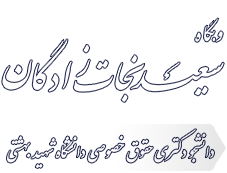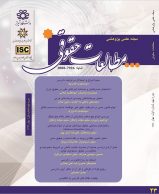بررسی ابعاد پیوندهای مختلف اینترنتی از منظر حقوق مؤلف
(DOI): 10.22099/JLS.2017.4101
نویسندگان:
ابراهیم رهبری (۱)؛ سعید نجات زادگان(۲)؛ حمید نجات زادگان(۳)
(۱) استادیار گروه حقوق مالکیت فکری و فضای مجازی دانشگاه شهید بهشتی
(۲) دانشجوی دکترای حقوق خصوصی دانشگاه شهید بهشتی
(۳) دانشجوی دکترای حقوق خصوصی دانشگاه آزاد علوم و تحقیقات تهران
چکیده:
امروزه تصور طراحی یک وبگاه اینترنتی بدون استفاده از پیوندها دشوار است. پیوندهای اینترنتی در یکی از سه قالب پیوندهای فرامتنی، تصویری و پنجرهای، کاربران را به سرعت و سهولت در فضای وب به گردش در میآورند، امری که ممکن است حقوق انحصاری صاحبان آثار فکری را در مخاطره قرار دهد.
مهمترین نقطه تلاقی چالشهای پیوندهای اینترنتی با مالکیتهای فکری، در چارچوب نظام کپیرایت و موارد احتمالی تعدی به حقوق دارندهی آن متبلور میشود. این مقاله میکوشد در بستری فنی و حقوقی، اقسام لینکها و کارکرد هریک را در فضای دیجیتال بررسی کرده و حقوق صاحبان وبگاهها را در مواجهه با پیوندهای اینترنتی تبیین سازد. همچنین این پژوهش تلاش میکند تا در پرتو رویهی قضایی و قواعد تثبیت شده حق مؤلف در کشورهای پیشرو و موازین مربوطه در حقوق ایران و به خصوص مقررات قانون تجارت الکترونیک، مواردی را که احتمال دارد پیونددهی به نقض کپیرایت منجر شود از موارد مشروع بازشناسی و تبیین نماید.
An Analysis on Different Internet Links from the Perspective of Copyright System
Authors: Ebrahim Rahbari؛ Saied Nejatzadegan؛ Hamid Nejatzadegan
Abstract:
Nowadays, it is almost impossible to design a website without utilizing of links. Different types of Web links (Hyperlinks, IMG links and Frame links) circulate users on the web and refer them into places which linker had determined previously. This issue may endanger exclusive rights of intellectual property holders.
Although sometimes Links had infringed trademarks and somewhere are recognized as unfair trade practice, the most important talented point of their controversies in the intellectual property system is located under the copyright and possible infringement of its exclusive rights.
This article tries to describe technical and legal issues of various types of links and their functions and determine the rights of web page owners in this regard. In addition, this research endeavors to differentiate cases which can be considered as unconventional linking in contrast to legal linking in the light of judicial precedent and related established copy rights in the leading countries and Iranian rules specially Electronic commerce Code.
فهرست منابع
الف. منابع فارسی
زرکلام، ستار(۱۳۸۸). حقوق مالکیت ادبی و هنری. تهران: انتشارات سمت.
صادقی، حسین(۱۳۹۳). «حمایت از حق مؤلف در فضای سایبر در حقوق ملی و اسناد بین المللی». دیدگاههای حقوق قضایی، ش ۶۵. ۶۲-۳۷٫
ب. منابع انگلیسی
Meeker ،Heather J. (2010). Technology Licensing: A Practitioner’s Guide. Section of Science and Technology Law، USA: American Bar Association.
Arezzo, Emanuela. (2014). “Hyperlinks And Making Available Right In The European Union – What Future For The Internet After Svensson?” IIC 45 (5): 524–۵۵۵٫
Beal, Kara. (1998). “The Potential Liability of Linking On The Internet: An Examination Of Possible Legal Solutions.” BYU L. Rev., 703.
Bidgoli, H. (2004). The Internet Encyclopedia. USA: John Wiley & Sons.
Bond, Nicole M. (1998). “Linking and Framing On the Internet: Liability under Trademark and Copyright Law.” DePaul Bus. LJ 11: 185.
DAS, J. K. (2015). Law of Copyright. PHI Learning.
Evening, Martin. (2015). Photographers at Work: Essential Business and Production Skills for Photographers in Editorial, Design, and Advertising. Pearson Education.
Ezor, Jonathan, (Accessed 17 Nov. 2015). “OPINION: Avoiding Trademark, Copyright Infringement.” AdvertisingAge. http://adage.com/article/news/opinion-avoiding-trademark-copyright-infringement/269/.
Fischer, Mark A, E. Gabriel Perle and John Taylor Williams. (2015). Perle, Williams & Fischer On Publishing Law. New York: Wolters Kluwer Law & Business.
Gasaway, Laura N. (2013). Copyright Questions and Answers for Information Professionals: From the Columns of Against the Grain. Purdue University Press.
Gerber, D. A. and Practising Law Institute. (1998). Advanced Issues in Copyright Law. Practising Law Institute.
Jackson, Matt. (1996). “Linking Copyright to Homepages.” Fed. Comm. LJ 49: 731.
Jakobsen, S. S. and S. Schaumburg-Müller. (2011). Media Law In Denmark. Kluwer Law International.
Kienle, Holger, Daniel German, Scott Tilley and Hausi Muller. (2008). “Managing Legal Risks Associated With Intellectual Property On The Web.” International Journal of Business Information Systems 3 (1): 86–۱۰۶٫
Lake, Susan and Karen Bean May. (2007). the Business of Technology: Digital Multimedia. Cengage Learning.
Lipton, J. (2015). Rethinking Cyberlaw: A New Vision for Internet Law. Edward Elgar Publishing Incorporated.
Madoff, Emily. (1997). “Freedom to Link under Attack: Web Community Up In Arms over Lawsuits.” New York Law Journal, March.
Maniōtēs, D. N. (2011). Cyber Law in Greece. Kluwer Law International.
Millstein, Julian S., Jeffrey D. Neuburger and Jeffrey P. Weingart. (2014). Doing Business on the Internet: Forms and Analysis. Law Journal Press.
Norwitz, Trevor S., Mark L. Reinstra and Faiza J. Saeed. (2001). Counseling Clients in the New Economy: Opportunities for the Emerging and Established Company. Practising Law Institute.
Permohammed, S. (2012). Protecting Brands Online. Thomson Reuters.
Raysman, Richard and Peter Brown. (1997). “Dangerous Liaisons: The Legal Risks Of Linking Web Sites.” NYLJ 217: 66.
Roarty, Allison. (1999). “Link Liability: The Argument for Inline Links and Frames as Infringements of the Copyright Display Right.” Fordham L. Rev. 68: 1011.
Ross, Terence P. (2000). Intellectual Property Law: Damages and Remedies. Law Journal Press.
Rowland, D. and E. Macdonald. (2005). Information Technology Law. Cavendish.
Sableman, Mark. (1997). “Business on the Internet, Part II: Liability Issues.” JOURNAL OF MISSOURI BAR 53: 223–۲۳۱٫
Schwabach, Aaron. (2014). Internet and the Law: Technology, Society, and Compromises. Abc-clio.
Singh, M. P. (2004). The Practical Handbook of Internet Computing. CRC Press.
Singh, Yatindra. (2010). Cyber Laws: A Guide to Cyber Laws, Information Technology, Computer Software, Intellectual Property Rights, E-Commerce, Taxation, Privacy, Etc. Along With Policies, Guidelines and Agreements. Universal Law Publishing.
Smith, G. J. H. and R. Boardman. (2007). Internet Law and Regulation. Sweet & Maxwell.
Smith, Graham, Phil Sherrell and Will Smith. (Accessed 17 Nov. 2015). “CJEU Decision In Svensson – Hyperlinks to Freely Available Content Are Permitted.” Bird & Bird. http://www.twobirds.com/en/news/articles/2014/global/cjeu-decision-in-svensson-hyperlinks-to-freely-available-content.
Sople, v. V. (2012). Managing intellectual property: the strategic imperative. Phi learning.
Spindler, G. and F. Börner. (2013). E-Commerce Law in Europe and the USA. Springer Berlin Heidelberg.
Spink, A. and M. Zimmer. (2008). Web Search: Multidisciplinary Perspectives. Springer Berlin Heidelberg.
Stamatoudi, Irini A., ed. (2010). Copyright Enforcement and the Internet. Information Law Series 21. Alphen aan den Rijn: Kluwer Law International.
Stim, Richard. (2013). Getting Permission: How to License & Clear Copyrighted Materials Online & Off. Nolo.
Trout, B. J. and K. Torke. (2007). Cyber Law: A Legal Arsenal for Online Business. World Audience.
Walden, I. and J. Hörnle. (2001). E-Commerce Law and Practice in Europe. Elsevier Science.
Wassom, Brian D. (1998). “Copyright Implications of‘Unconventional Linking’ On the World Wide Web: Framing, Deep Linking and Inlining.” Case W. Res. 49: 181–۸۶۹٫
Weakley, S. L. (2015). Financing and Protecting California Businesses. Continuing Education of the Bar-California.
Weston, N. D. (2015). Trap Hippie’s Understanding Copyrights and Trademarks for Entertainers. Trap Hippie.




